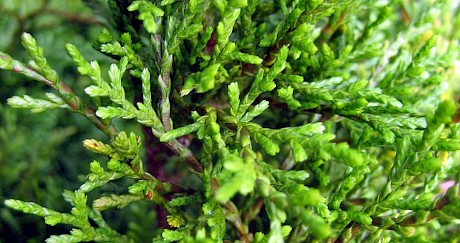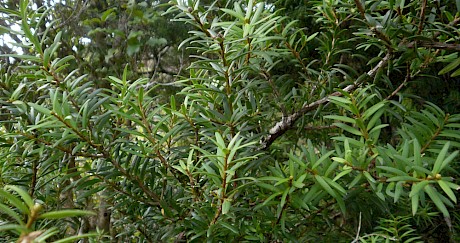Kowhai (Sophora tetraptera and S microphylla)
(Kowhai is the National Flower of New Zealand)
History
Early Maori used the wood of kowhai for a wide variety of purposes which utilised its durability, elasticity and toughness. It made wedges which were used to split wood: it was used for fences and in whare construction, implements and weapons such as kō, patu, eel spears and taiaha, and carefully selected kowhai roots were used to make large fish hooks. Although it was used for bowls and other utensils it has been recorded that people became ill from eating from a spoon made of kowhai wood. Various infusions of kowhai bark (normally taken from the sunny side of the tree) were however used extensively for medicinal purposes, including as a purgative, treatment of scabies, poultices for sprains, bruises, tumours, and wounds, a cure for gonorrhoea and ringworm and relief from colds and sore throats. Flowers, seedpods, twigs and bark all yielded dyes of various hues between yellow and brown. The small size of most trees restricted its use by European settlers. Main uses were for sleepers, house blocks, fence posts and piles. Its toughness and durability also made it valuable for the teeth and bows of hayrakes, shafts and other implements and for cabinet work. It is understood that there is a woolshed in the Wairarapa built from kowhai timber.
Another aspect of the history of kowhai is its use as a garden plant. Because its bright yellow flowers drew the attention of the first visitors to New Zealand, seed was taken to many places in the world. Banks took seed back to Kew where it was grown and kowhai was planted from about 1772 – flowering trees being recorded in London in 1779 and in Ireland in 1800.
Distribution
While the smaller S. microphylla is found up to 800 metres altitude in lowland and lower montane sites areas over most parts of New Zealand, the larger S tetraptera is confined to lowland streamsides and forest margins from East Cape to Wairarapa. Because of its ornamental use, both species of kowhai are now found throughout New Zealand. Kowhai are frost hardy and moderately wind and drought tolerant. They do not grow well on hard or waterlogged soils, being best on moderately fertile sites. S tetraptera is not as hardy as S microphylla.
Most of the information in this article relates to both the main tree species of kowhai. At this stage it is not known which species might be more useful for timber production. In addition, several new species of Sophora were determined few years ago from the huge variations which exist, particularly in S microphylla. Whether or not these new species have any potential for timber production is unknown.
Tree size and growth
Normally up to 12 metres tall for S tetraptera and 10 metres for S microphylla with both growing to 60 cm diameter. The tallest recorded has reached 20 metres in height. Measurements of trial plantings in eleven New Zealand locations showed initial height growth of about 45 cm per annum, slowing to less than 20 cm for 80 year old trees. Diameter growth averaged 8 mm per annum for trees up to 20 years old, dropping to between 4 and 5 mm after 35 years. Assuming that properly managed planting could grow faster it is reasonable to expect that trees 20 metres tall and 50 cm diameter could be grown in 50 years.
Nitrogen fixation
Kowhai is a legume and nodules on its roots fix nitrogen. For this reason, and because it is New Zealand’s only deciduous tree, it may have an important role to play in continuous cover forestry in this country.
Timber
Kowhai heartwood is yellowish-brown in colour with darker streaks, and is tough, elastic and durable in the ground for at least 20 years. It is one of New Zealand’s strongest hardwoods. The wood is lustrous and finishes well although it is prone to cracking when drying. It is a useful turner timber.
Timber characteristics, with P radiata figures shown in brackets for comparison, are as follows: -
Density @ 12% m.c 770 kg/ m³ (500 kg/m³)
Moisture content: green (130%)
Tangential shrinkage -green to 12% m.c (4.7%)
Radial shrinkage (2.2%)
Modulus of rupture 135 Mpa (90 Mpa)
Modulus of elasticity 13.6 Gpa (9 Gpa)
Damaging agencies
Kowhai is attacked by the caterpillar of the kowhai moth (Uresiphita polygonalis maorialis) which can completely defoliate trees; however observation suggests that the tree is tolerant of defoliation. It appears that the moth may be subject to periodic viral or bacterial disease which keep populations in check. The New Zealand drywood termite is known to attack dead, sound kowhai wood.
Potential
No research appears to have been done to investigate the multi use possibilities of kowhai. It has the potential to produce useful medicines and dyes; it can fix nitrogen – a valuable attribute in a country where most soils are somewhat deficient in that important nutrient; it is durable, tough and elastic – attributes also in short supply in most New Zealand timber species; its potential for furniture and cabinet work is also high and finally, it may have an important role to play in continuous cover forestry.
Research requirements
Research into every aspect of growing and utilising kowhai is urgently needed. To begin with comparative growth trials of both main species, and the new species recently determined, plus its use as species in Continuous Cover mixtures should have high priority.
References
- Allan H H 1961. Flora of New Zealand Vol. 1 Government Printer Wellington
- Brooker S G, Cambie R C & Cooper R C 1988. Economic Native Plants of New Zealand. Botany Division, D.S.I.R
- Brooker S G, Cambie R C & Cooper R C 1981. New Zealand Medicinal Plants. Heinmann
- Burstal S W & Sale E V 1984. Great Trees of New Zealand
- Clifton N C 1990. New Zealand timbers
- Howard A L 1948. A manual of the timbers of the world. MacMillan & Co, London
- Kay M K 1980. Uresiphita polygonalis maorialis (Felder) Kowhai moth. Forest and timber insects in New Zealand No. 42. Forest Research Institute, Rotorua. 8p
- Milligan R H 1984. Kalotermes brouni (Froggatt) New Zealand Dry wood Termite. Forest and timber insects in New Zealand No. 59. Forest Research Institute, Rotorua. 8p
- Pardy G F, Bergin D O & Kimberley M O 1992. Survey of Native tree plantations. FRI Bulletin 175
- Pollock K M 1986. Plant materials handbook for soil conservation; Vol 3: Native plants. Water and Soils Misc Publication No. 95. Soils Conservation Centre, Palmerston North.
- Tipa R 2004. Kowhai: Our national Flower. In Te Karaka, 25.(Spring 2004) pg 16 - 17
Species profile by Ian Barton


